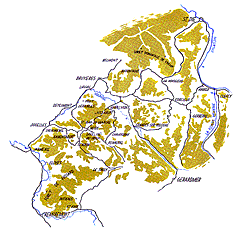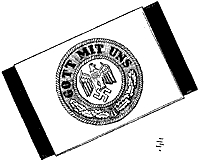|
|
|
|
IX Forging the Vosges |
|
For some of us it was a new experience battling it out with the enemy and the terrain yard by yard, but for others it recalled bitter memories of the Italian campaign. The mountains, the mud, and the mine fields were in front of us once again, but, unlike Italy, there was no Rome glittering on the horizon. After one mountain was gained there was nothing ahead but another, always another mountain, higher and more heavily defended than the last. Seldom did our thoughts reach out beyond these confining barriers. Only occasionally did we talk of the Alsace Plain and the Rhine beyond. Even less did the armchair strategists among us discuss the war in broad outlines. Our horizon was a limited one, extending only to the particular valley or forested hill immediately in front of us. More often it stretched only a few hundred yards ahead through a maze of pine trees or to a farmhouse at the edge of a woodline. Ours was an outlook as provincial as the isolated peasants around us, but we were too occupied to be concerned with more than our immediate surroundings. A small strip of land became our sole interest, our life. We weren't in the Vosges Mountains long before we realized that the Germans were not our only enemy. Jerry had made an ally of the forested hills and rugged terrain. The high mountain peaks gave him OP's; the dense forest growth, concealment. Practically every natural advantage was his. It was a terrain friendly to the defender, hostile to the attacker. What defenses nature failed to furnish, Jerry provided for himself. With characteristic effeciency he constructed well dug-in positions. Every rifleman and machine gunner had deep, heavily covered foxholes that looked down on the only lanes of approach open to us. Jerry had always been a master of camouflage, and his dug in positions in the Vosges forests, which made use of every available leaf and pine needle, showed that he had lost none of his technique. Many of us never saw his positions until we were right on top of them, and then it was usually too late. Mine fields, which had been such a curse to us in Italy, became a part of the Vosges landscape as the dreaded, footshearing Schu mines were sprinkled over the ground before us. Planted under the forest floor, their trip wires camouflaged by the maze of twigs and underbrush, they were an unseen, but ever present, enemy. Every step was a probed one as a misstep meant a foot, a leg, or sometimes even a life. Then there was the artillery. If ever the Germans and the forest seemed allied, it was never more noticeable than
when enemy artillery shells burst in the tree-tops, spraying metal down on us like rain
falling from an evil sky. Forever on the attack, we rarely had time enough to dig
deep-foxholes and almost never the chance to cover them. A mere hole in the ground was no
protection against shell fragments falling from above — we could only stay there and
sweat it out. Even a little artillery was able to do a lot of damage in these woods. The
destructiveness of one tree burst alone was equal to several shells exploding in open
ground. But for the first time in France the Germans had the artillery. "They fired
all the time. They fired more than we did, and it's the only time I ever saw that
happen," remarked an Engineer officer who had been forced to commit his company on
the line as infantry and was undergoing his first experience with tree bursts. They had
the SP's, too, and these high velocity 88's, As the last pieces of artillery were moved across the Moselle river, we were working our way south along the Vosges foothills and probing the dense, fog shrouded woods of the ForÍt De Fossard. On the 25th of September the 1st Battalion succeeded in blocking the Remiremont-St. Ame road. The 3rd Battalion, proceeding farther south, cleared the north section of Remiremont. A patrol was then sent back across the river to make contact with the 142nd Infantry Regiment, which was still mopping up the main part of the town situated on the west bank. The following day the 1st and 2nd Battalions, advancing east through the heavily mined ForÍt De Fossard against extremely stubborn resistance, cleared St. Ame and Putieres. Heavy rains and fog made the registering of supporting artillery fire extremely difficult in this area. As September drew to a close we mounted trucks and rode to Chenimenil, passing through Eloyes and Jarmenil. The 1st and 2nd Battalions marched out of Chenimenil on foot and through Tendon, preparatory to a night attack on Houx, while the 3rd Battalion moved to the high ground southeast of Tendon, attached to the 142nd Infantry. As the 1st Battalion approached the outskirts of Houx, it was subjected to extremely heavy self-propelled and artillery fire. Heavy casualties were sustained and the battalion badly disorganized. The 2nd Battalion, which had been in support of the attack, escaped with few casualties. Orders were then received for our regiment to relieve elements of the 143rd Infantry east of the Jarmenil-Bruyeres road, and the 1st and 2nd Battalions were sent back to Docelles and northeast along the Bruyeres road to attack the Houx Valley from the rear. St. Jean du Marche was entered by Company F on the 29th of September against no opposition, but as the 2nd Battalion began to move north from the town it encountered resistance on the northern outskirts. The 1st Battalion, pushing northeast of St. Jean du Marche, ran into strong resistance and was fired upon by enemy self-propelled guns and artillery. With supporting armor, the battalion gradually fought its way northeast to Lepanges.
|
|
Copyright © 1945, 1998 141st Infantry Regiment
Association. |


 bursting in the treetops, added to the hail of shell fragments descending
upon us. If at night the artillery let up somewhat, it did not cease. The night only
served to illuminate the reddish glare of the shell bursts and to magnify their explosive
crash against the trees, causing them to appear closer to us than they actually were. The
darkness of the evenings filled the forest with a dreaded stillness which was irregularly
broken by weird and nerve-wracking noises. The pine trees, swaying in the wind, whistled
eerily, much as artillery shells skimming overhead. Branches fell from the aging trees and
knocked against tree trunks and limbs on their way to the ground, much as spent shell
fragments would batter against the trees around us. Twigs would snap and leave's would
rustle on the ground, suggesting the tread of approaching feet, but more often than not it
would be merely the wind playing with the forest growth. The night seemed to delight in
playing tricks on us. Sometimes the trees, silhouetted against the skyline, would dress up
like humans with long bayonet-like limbs ready to strike down on us. Every twig seemed to
conceal a Schu mine, every bush a sniper. Night time seemed an infinity. If the Germans
were an enemy, the woods and the hills were a more dangerous enemy. Jerry was something
real, but the dense forests, especially at night, contained things intangible and unseen
that played heavily upon our imagination and allowed us little rest.
bursting in the treetops, added to the hail of shell fragments descending
upon us. If at night the artillery let up somewhat, it did not cease. The night only
served to illuminate the reddish glare of the shell bursts and to magnify their explosive
crash against the trees, causing them to appear closer to us than they actually were. The
darkness of the evenings filled the forest with a dreaded stillness which was irregularly
broken by weird and nerve-wracking noises. The pine trees, swaying in the wind, whistled
eerily, much as artillery shells skimming overhead. Branches fell from the aging trees and
knocked against tree trunks and limbs on their way to the ground, much as spent shell
fragments would batter against the trees around us. Twigs would snap and leave's would
rustle on the ground, suggesting the tread of approaching feet, but more often than not it
would be merely the wind playing with the forest growth. The night seemed to delight in
playing tricks on us. Sometimes the trees, silhouetted against the skyline, would dress up
like humans with long bayonet-like limbs ready to strike down on us. Every twig seemed to
conceal a Schu mine, every bush a sniper. Night time seemed an infinity. If the Germans
were an enemy, the woods and the hills were a more dangerous enemy. Jerry was something
real, but the dense forests, especially at night, contained things intangible and unseen
that played heavily upon our imagination and allowed us little rest.